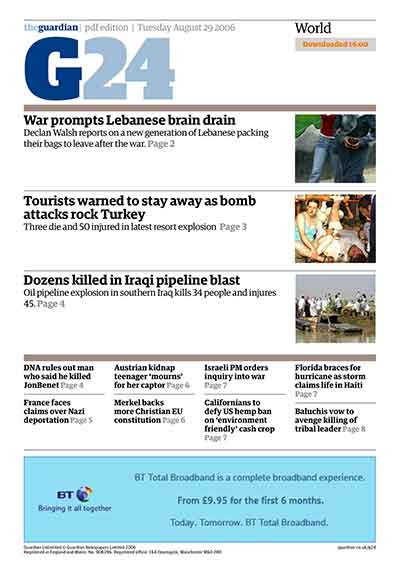Crystal balls
September 1st, 2006The mysterious Derek Hill just has to let us know where to find a higher resolution version of this wonderful image – I want it for a PowerPoint slide background! From Seth Godin’s blog.

The mysterious Derek Hill just has to let us know where to find a higher resolution version of this wonderful image – I want it for a PowerPoint slide background! From Seth Godin’s blog.

Another piece of text for staff development. I may podcast this one with an interview with teachers who use e-mail
A colleague recently asked me “was it OK to carry on using e-mail or should I look at something more recent like blogs?”
The colleague in question had an organised set of distribution lists (and taught her students how to set up their own lists) and used e-mail mainly to provide feedback and set targets on a one to one basis, so there was no need to add another facility to the mix. There might be a case for a class blog if ‘visibility’ for the course (or tutor) will be politically useful within the organisation and if there is enough common material being posted each week or if the main support need was to provide links to Web sites of value to the students.
I think that e-mail is a most effective way of providing one to one support and feedback to students between lessons. I also think that many adult students could benefit from the experience of taking part in structured e-mail correspondence – including receiving, filing, editing and sending attached files – as a general ‘life skill’.
One technical point regarding attached files: the cheaper laptops sold on the high street tend to have MS Works installed in place of Microsoft Office. MS Works is a basic and useful package including a word processor, spreadsheet and graphics software but it saves files in a special format of its own. You might want to ask your IT support people to install the MS Works import filter, this is a free download from Microsoft but you usually need administrative access to your staff computer to install filters. You can then open and read WPS files from within Word, and you can save files in WPS format. Students who use MS Works might want to learn how to save their word-processing files in Rich Text Format (RTF). RTF files can be read by any recent word processor on any operating system. I recently had to help a manager convert a CV that had been sent by e-mail as an attached file in WPS format – not a good way of making an initial impression!
A simple framework for supporting a group of students by e-mail includes three phases;
I’m assuming that you are supporting a face to face course and that all the usual advice, guidance; diagnostic tests and so on have been completed. See Duggleby 2000 for a comprehensive set of templates for running a purely distance learning based course

Print your own A4 format newspaper from a PDF file on the Guardian Unlimited Web site. G24 is available in different sections (which I guess might overlap); Top Stories, World, Media, Business, Sport. Each seems to have around 10 or 11 pages of content, and the photos are small. There is some advertising (see the low resolution screen grab of the front page from the World section above). The articles are short.
Just what I need to get students reading more widely than the Metro. I’ll be leaving a few copies of the News and Top Stories sections in the base room a few times a week. Printing your own newspaper is one of those science fiction things I remember being suggested as a child… funny how they didn’t think of blogs or the Internet then? It was always the same thing distributed in a different way, not a different thing entirely as some think the future of newspapers will be.

It is often late on a Sunday or bank holiday. This morning (Tuesday), no problems. Cost cuts on support staff?
I wonder, though, if “good enough” might be the next big idea. Audio players, cars, dryers, accounting… not the best ever made, not the most complicated and certainly not the most energy-consuming. Just good enough. Seth Goldin on his blog
I think GoodEnough© might be the next thing as long as these appliances JustWork™. I’m trying to find a digital camera that has a fixed focal length lens with a field around 65 degrees (35mm focal length on 35mm film) a relatively low f number (f/2 or f/2.8) and that can take pictures in the twilight. I don’t need zooms, menus, and long delays between the pressing of the button and the recording of the image. I don’t even need the LCD if there is a view-finder, but I suppose people expect LCDs now.
The digital voice recorders are GoodEnough right now – please Olympus, no more functions!
Here is the last plain text quick quiz. I’ll start using Word/Open Office and PDF files now as I need fraction notation. This one covers rounding to decimal places and significant figures, converting to and from Standard Form, and adding and subtracting directed numbers.
I will also start to do the hot potatoes versions with different questions: the aim of the series is to consolidate the basic content of the last lesson in the first 10 minutes of the current lesson. The tests are marked by the students themselves and the aim is to encourage engagement with the basics of each topic. The sequence may help with the ‘functional skills’ aspect of the new GCSE syllabus as well, but I need to do some more reading on that one.
Again, try these questions without a calculator.
Copy and complete the table below
| 1) | Number | 1sf | 2sf | 3sf |
| 2) | 1763 | ________ | ________ | ________ |
| 3) | 39.67 | ________ | ________ | ________ |
| 4) | 3.14159 | ________ | ________ | ________ |
| 5) | 0.00017295 | ________ | ________ | ________ |
| 6) | 0.053276 | ________ | ________ | ________ |
[...] Human behavior seldom follows mathematical logic and reasoning. By the standards of engineers, human behavior can be illogical and irrational. From the standpoint of people, however, their behavior is quite sensible, dictated by the activity being performed, the environment and context, and their higher-level goals…. Don Norman
Enrolment is upon us and we are managing thousands of people through a complex process that we do once a year in mass (although flexible and short courses recruit all year).